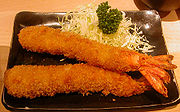
Fried prawn
Encyclopedia

Deep frying
Deep frying is a cooking method in which food is submerged in hot oil or fat. This is normally performed with a deep fryer or chip pan; industrially, a pressure fryer or vacuum fryer may be used....
cuisine
Cuisine
Cuisine is a characteristic style of cooking practices and traditions, often associated with a specific culture. Cuisines are often named after the geographic areas or regions that they originate from...
popular in Japan as well as Japanese restaurants worldwide. It is a speciality of the city of Nagoya.
A popular ingredient of Japanese bento
Bento
is a single-portion takeout or home-packed meal common in Japanese cuisine. A traditional bento consists of rice, fish or meat, and one or more pickled or cooked vegetables, usually in a box-shaped container. Containers range from disposable mass produced to hand crafted lacquerware...
, is a common menu item at bentō shops.
Traditionally Kuruma Ebi was used, but since a decline in its cultivation, many stores have started using black tiger shrimp
Penaeus monodon
Penaeus monodon, the giant tiger prawn , is a marine crustacean that is widely reared for food.-Distribution:...
and Ise Ebi
Japanese spiny lobster
The Japanese spiny lobster, Panulirus japonicus, is a member of the Panulirus genus of spiny lobsters. It grows up to long and lives in the Pacific Ocean around Japan, China, Korea and Taiwan. P. japonicus is the subject of commercial lobster fishery in Japan. It is a popular item in high-class...
. It is thought that ebi furai was created around 1900 in response to the growing popularity of similar dishes such as Tonkatsu
Tonkatsu
Tonkatsu , invented in the late 19th century, is a popular dish in Japan. It consists of a breaded, deep-fried pork cutlet one to two centimeters thick and sliced into bite-sized pieces, generally served with shredded cabbage and/or miso soup...
and minced meat cutlets in the Western food restaurants of Ginza
Ginza
is a district of Chūō, Tokyo, located south of Yaesu and Kyōbashi, west of Tsukiji, east of Yūrakuchō and Uchisaiwaichō, and north of Shinbashi.It is known as an upscale area of Tokyo with numerous department stores, boutiques, restaurants and coffeehouses. Ginza is recognized as one of the most...
and Tokyo
Tokyo
, ; officially , is one of the 47 prefectures of Japan. Tokyo is the capital of Japan, the center of the Greater Tokyo Area, and the largest metropolitan area of Japan. It is the seat of the Japanese government and the Imperial Palace, and the home of the Japanese Imperial Family...
.
Cooking
Each prawn is straightened out flat, and a small incision made along its back. The gritty tasting digestive tract is then pulled out of this incision.The prawn is then coated with flour, beaten egg and breadcrumbs in that order, and deep-fried in hot cooking oil.
The head is usually removed before cooking. However if the prawn is fresh enough, it may be cooked and served whole. Some people prefer to eat the head, which becomes crispy.
Fried prawns are often eaten with a choice of thick Worcester sauce, Hoisin sauce
Hoisin sauce
Hoisin sauce, or haixian sauce, is a Chinese dipping sauce. The word hoisin is a romanization of the Chinese word for seafood "" as pronounced in Cantonese.-Ingredients:...
, lemon juice or tartare sauce.
Derivatives
Ebi-donDonburi
Donburi is a Japanese "rice bowl dish" consisting of fish, meat, vegetables or other ingredients simmered together and served over rice. Donburi meals are served in oversized rice bowls also called donburi...
(エビ丼, fried prawn and egg over rice) - the prawns are brushed with egg only, and placed on top of a bowl of hot rice.
Fun facts
The reason ebi furai is acknowledged as being one of Nagoya's speciality foods is mainly due to a joke made by the popular Japanese tarento TamoriTamori
is a Japanese celebrity. His real name is and the screenname Tamori is an anagram of his surname. He was born on 22 August 1945 in Fukuoka City in Fukuoka Prefecture....
about ebi furai being called ebi furyaa in Nagoya-ben. Whilst this word did not actually exist in Nagoya-ben prior to his joke (as gairaigo
Gairaigo
Gairaigo is Japanese for "loan word" or "borrowed word", and indicates a transliteration into Japanese. In particular, the word usually refers to a Japanese word of foreign origin that was not borrowed from Chinese, primarily from English. Japanese also has a large number of loan words from...
generally does not change in Japanese dialects), it led a large portion of the Japanese population to believe that this variation of the word ebi furai actually existed in Nagoya-ben.

